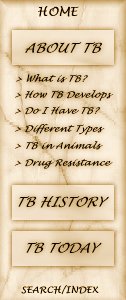
Other Forms of Tuberculosis
Bones and Joints |
 |
|
 A small group of TB germs already in the bones and joints, having reached them by way of the blood stream, may be stimulated to grow and spread because of a breakdown of the body’s resistance. The germs most often attack the spine, less often the hip, knee, foot, ankle, and other sites.
A small group of TB germs already in the bones and joints, having reached them by way of the blood stream, may be stimulated to grow and spread because of a breakdown of the body’s resistance. The germs most often attack the spine, less often the hip, knee, foot, ankle, and other sites.
When it attacks the knee, the disease spreads and inflames the lining of the joint. Fluid collects and destruction of the bone begins. The person suffers pain, swelling, and stiffness, forcing a limp. As the disease gets worse, abscesses may appear.
Crying out at night is a peculiar characteristic of children with tuberculosis of the spine. It results from pain occurring when the tense back muscles bracing the spine relax.
Tuberculosis in the bones and joints was observed most often in children and young adults. It was common in the past, before the pasteurization of milk and the virtual elimination of tuberculosis from cows. Because the number of persons with TB has been reduced, too, and because of preventive therapy, children are exposed to it far less often. If TB involvement does develop in the bones and joints, it is necessary to find and treat it quickly to prevent permanent deformity and crippling. Early drug treatment usually avoids need for surgery in these cases.
